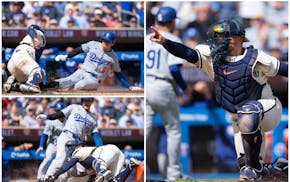GANGNEUNG, SOUTH KOREA – The official hockey rulebook clearly states that body-checking in women's hockey is prohibited.
That's a real knee-slapper.
Team USA's Hilary Knight practically rolled her eyes when I mentioned the no-checking rule.
"I don't know about that," she said.
Me either. Watch an Olympic women's hockey game and then try to convince someone that there is no checking in that sport. Especially if that contest pits the U.S. vs. Canada.
Those archrivals check, hit, shove and punch each other for 60 minutes every time they square off. They probably would bite too, if that sort of thing wasn't frowned upon.
The no-checking rule should be placed in air quotes. It seems more like a suggestion than a hard and fast rule.
"Technically, there's no checking allowed in women's hockey," Knight said. "But you've got some great athletes here that are looking to win a 50-50 battle and you're going to sacrifice your body to make a play."
Body contact is allowed and embraced. Anyone still clinging to the belief that women's hockey isn't physical clearly hasn't watched a second of this Olympic tournament. Players are delivering serious punishment as they fight for every inch of ice.
"I would probably say it's the most physical tournament I've been a part of in my international career," U.S. forward Monique Lamoureux-Davidson said. "Some tournaments [referees] let it go, kind of like they have for this entire tournament. Or they call everything. I'd rather be on the side of less penalties."
Open-ice hits usually are a strict no-no, but even that's not being called 100 percent of the time. In Monday's semifinal, U.S. captain Meghan Duggan nailed Finland defenseman Ronja Savolainen as she skated up ice. It appeared to be knee-on-knee.
Savolainen crumpled and then crashed headfirst into the boards. It was a scary hit. Savolainen needed assistance from several teammates as she left the ice, though she was able to return in the second period.
Amazingly, no penalty was called.
The referees skated to both benches to discuss it with the coaches before play resumed.
"They just said it was a collision," U.S. coach Robb Stauber said. "They couldn't just make it up. They saw it as a collision."
Well, it certainly wasn't a harmless nudge.
Both Stauber and Duggan said they don't think she will face any punishment that will affect her status for the gold medal game.
"You never want to see a player go down with any injury," Duggan said. "Really happy that she was able to get up. Our team wishes her the best. It's a physical sport, obviously. Our team plays clean and within the rules."
The rules seem open to interpretation in the women's game. Some hits are ignored, some hits get penalized. Players said they try to find that roughhouse line early in the game to understand how far they can go.
"Usually you can feel it out to see what the refs are going to call," Lamoureux-Davidson said. "The biggest thing that players want is consistency throughout a whole game. If they're going to let it go, let it go the entire game."
The referees let headlocks go in the first battle royal between the U.S. and Canada in the preliminary round. There were so many goalmouth scrums that it looked like a high school wrestling tournament. One dogpile included no less than seven players who were either fighting to knock the puck in the goal, or fighting to keep the puck out.
"That's the money place," Knight said. "It's really a blood battle in front."
Knight has received a few messages from friends back home expressing amazement at the level of physical play. Her response: Well, duh.
"I don't know the difference," she said.
Players say their game has been this physical for a while. The Olympics has raised the intensity meter a few notches.
"I think women's sports kind of get a negative rap of not being fast or physical," Knight said. "I encourage people to watch a hockey game, regardless of gender. It's fantastic."
Fantastic and physical, even without checking.
Wink, wink.
Chip Scoggins • chip.scoggins@startribune.com

Scoggins: Finch feeling heat of the Suns as playoff battle looms
Scoggins: Why 'championship or bust' fits these Wolves

Scoggins: Anatomy of a game-saving play as Correa throws out Ohtani


